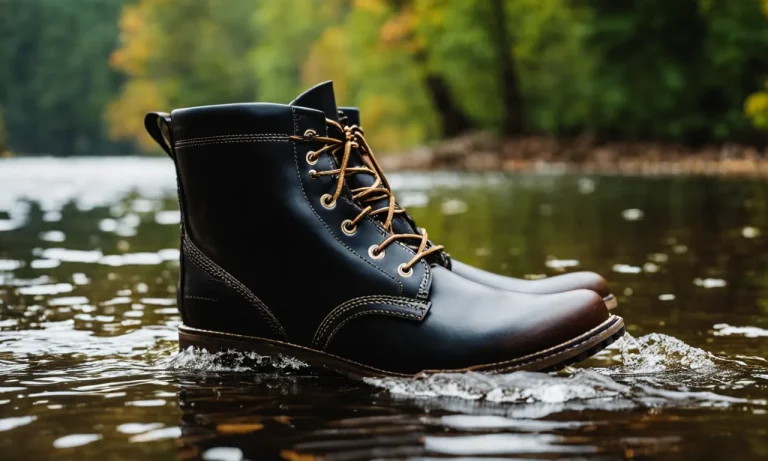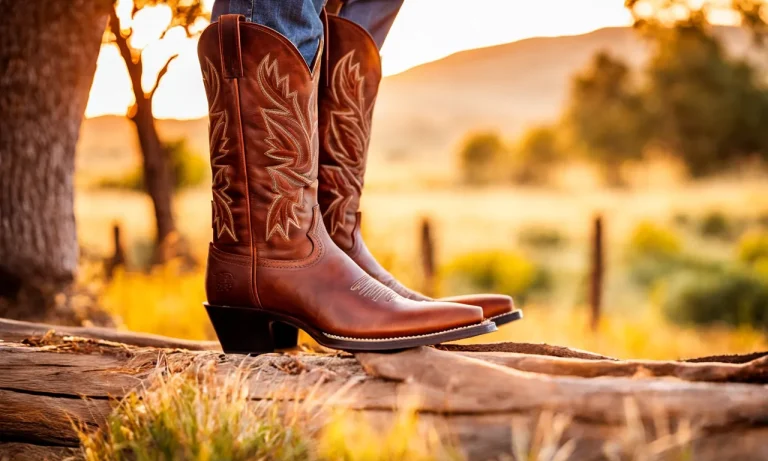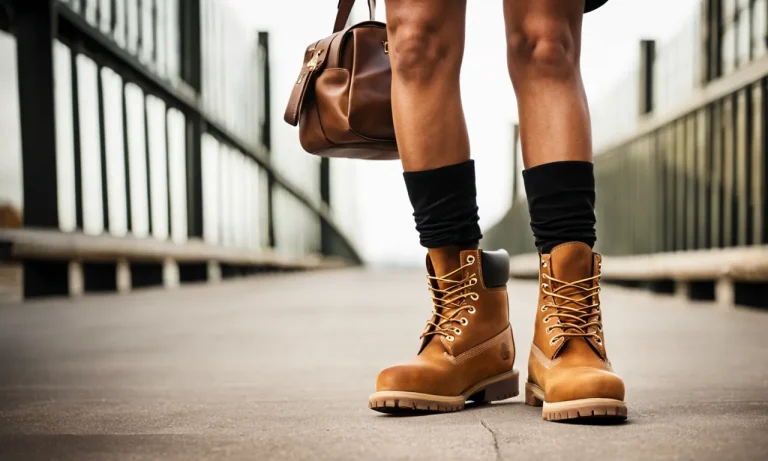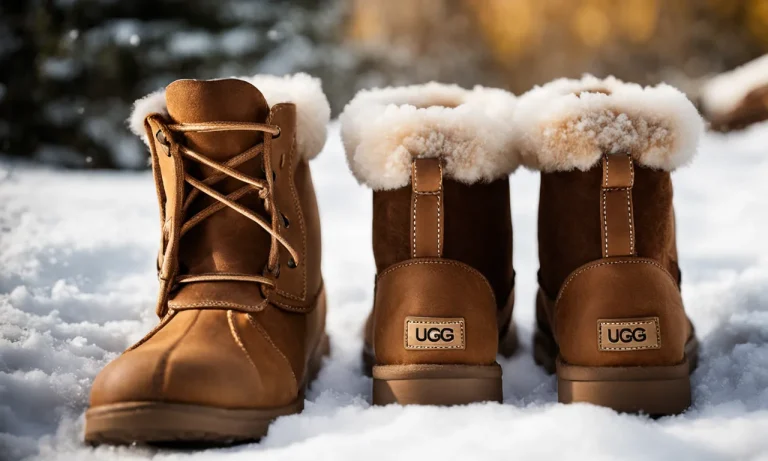For those living in cold, snowy climates, having proper footwear for the winter is crucial. Timberland boots have long been a popular choice, but how well do they really hold up in the snow? In this comprehensive guide, we’ll examine whether Timberland boots are a smart option for snowy weather.
If you’re short on time, here’s a quick answer: Timberland boots can be good for light snow, but may not provide enough traction and warmth for heavy snowfall. Their leather uppers are waterproof but not fully insulated.
However, with proper treatment and warm socks, many Timberland boots can handle moderate snow.
Timberland Boot Construction for Snow
Waterproof Leather Uppers
When it comes to braving the snow, Timberland boots are a popular choice for many outdoor enthusiasts. One of the key features that make Timberland boots suitable for snowy conditions is their waterproof leather uppers.
The premium full-grain leather used in their construction is treated to repel water, keeping your feet dry and comfortable even in wet and snowy environments. This ensures that you can confidently walk through slushy snow without worrying about your feet getting wet.
Lugged Rubber Outsoles
In addition to their waterproof uppers, Timberland boots are also equipped with lugged rubber outsoles that provide excellent traction on slippery surfaces. The deep grooves and aggressive tread pattern on the outsoles help to grip the snow and ice, reducing the risk of slipping and falling.
This feature is particularly important when navigating through snowy terrain or walking on icy sidewalks. Whether you’re hiking, shoveling snow, or simply running errands, the lugged rubber outsoles of Timberland boots will keep you steady on your feet.
Insulation/Lining
Keeping your feet warm in cold and snowy weather is essential, and Timberland boots have you covered in this department as well. Many Timberland boots come with insulation or lining that helps to trap heat and provide extra warmth.
Thinsulate™ insulation, for example, is a popular choice that offers excellent thermal protection without adding excessive bulk to the boots. This means that even in frigid temperatures, your feet will stay cozy and comfortable.
It’s worth mentioning that Timberland offers a range of boot models, each with its own specifications and features. Some models may have additional insulation or specialized linings specifically designed for extreme cold conditions.
Therefore, it’s always a good idea to check the product descriptions or consult with Timberland’s official website for more information on the specific boot model you are considering for snowy activities.
Advantages of Timberland Boots in Snow
Traction
One of the key advantages of Timberland boots in snowy conditions is their exceptional traction. The rugged rubber outsoles of Timberland boots are designed to provide superior grip on various surfaces, including icy and slippery terrain.
This helps to prevent slips and falls, allowing you to confidently navigate through snow-covered landscapes.
Water Resistance
Another major advantage of Timberland boots when it comes to snow is their excellent water resistance. The boots are constructed with high-quality materials, such as premium full-grain leather and waterproof membranes, to keep your feet dry and comfortable.
This feature is particularly important in snowy conditions where moisture can seep in and make your feet cold and wet. With Timberland boots, you can enjoy the snow without worrying about damp and uncomfortable feet.
Durability
Timberland boots are renowned for their durability, making them an excellent choice for snowy conditions. The boots are built to withstand harsh weather conditions and rough terrains, ensuring they can handle the challenges of walking in snow.
The sturdy construction and robust materials used in Timberland boots make them highly resistant to wear and tear. This means you can rely on your boots to last for multiple snow seasons, saving you money in the long run.
Limitations of Timberland Boots in Heavy Snow
While Timberland boots are known for their durability and ruggedness, they do have some limitations when it comes to heavy snow conditions. It is important to understand these limitations before venturing out into the snow with your Timberland boots.
1. Not Fully Insulated
One of the main limitations of Timberland boots in heavy snow is that they are not fully insulated. While they provide some level of insulation, they may not be sufficient to keep your feet warm in extremely cold temperatures.
It is recommended to wear thick socks or invest in additional insulation inserts to enhance the warmth provided by the boots.
2. Can Absorb Moisture
Another limitation of Timberland boots in heavy snow is their tendency to absorb moisture. Although Timberland boots are made with water-resistant materials, prolonged exposure to wet snow can result in the boots becoming saturated. This can lead to discomfort and even freezing of the feet.
It is important to treat your Timberland boots with a waterproofing spray and regularly clean and condition them to maintain their water-resistance.
3. Lack Ankle Support
Timberland boots are designed for general outdoor use and may not provide the same level of ankle support as specialized snow boots. In heavy snow conditions, where the risk of slipping and twisting your ankle is higher, the lack of ankle support can be a limitation.
It is recommended to exercise caution and take additional measures to ensure stability, such as using traction aids or opting for boots specifically designed for snow activities.
It’s worth noting that these limitations may vary depending on the specific model and features of Timberland boots. It is always a good idea to check the manufacturer’s recommendations and consider the intended purpose of the boots before using them in heavy snow conditions.
Tips for Wearing Timberlands in Snow
Weatherproof
One of the key factors to consider when wearing Timberland boots in the snow is their weatherproof capabilities. Timberland boots are known for their durability and water resistance, making them a suitable choice for snowy conditions.
The boots are typically made with premium waterproof leather and sealed seams to keep your feet dry and comfortable. However, it’s important to note that while Timberlands are water-resistant, they are not entirely waterproof.
So, it’s always a good idea to apply a waterproofing spray or treatment to enhance their ability to repel moisture.
Use Warm Socks
When venturing out in the cold and snowy weather, it’s essential to keep your feet warm. To maximize the insulation and comfort of your Timberland boots, opt for warm socks made from materials like wool or thermal fabrics.
These socks will help to retain heat and keep your feet cozy, even in freezing temperatures. Additionally, wearing moisture-wicking socks can help prevent sweat buildup and keep your feet dry throughout the day.
Improve Traction
Walking on slippery surfaces can be challenging, especially in snowy conditions. To improve traction and reduce the risk of slipping, there are a few things you can do. Firstly, consider investing in Timberland boots with a lug sole.
The deep treads on these soles provide excellent grip on various surfaces, including snow and ice. Additionally, you can also use traction aids such as ice cleats or crampons that can be attached to the sole of your boots for added stability and grip.
Furthermore, it’s important to maintain the condition of the sole by regularly cleaning off any dirt or debris that may accumulate. This will help to ensure that the treads remain effective and provide optimal traction.
Wear Gaiters
Gaiters are protective coverings that are worn over your boots and lower legs to keep snow, moisture, and debris out. They are particularly useful when wearing Timberland boots in deep snow or wet conditions. Gaiters can help prevent snow from entering your boots and keep your feet dry and warm.
They also provide an extra layer of insulation and protection against the elements. Make sure to choose gaiters that are water-resistant and have a secure fit to ensure maximum effectiveness.
By following these tips, you can confidently wear Timberland boots in the snow and enjoy their comfort, style, and durability even in harsh winter conditions.
Best Timberland Boots for Snow
6-Inch Premium Boots
If you’re looking for a reliable and stylish option for snowy conditions, the Timberland 6-Inch Premium Boots are a great choice. These boots are designed with waterproof leather uppers to keep your feet dry and protected from the elements.
The durable rubber outsoles provide excellent traction on slippery surfaces, making them ideal for walking in the snow. The 6-inch height offers added ankle support, keeping you stable and comfortable. Whether you’re shoveling snow or hitting the slopes, these boots are up to the task.
Thermolite Boots
For those who want extra insulation to keep their feet warm in the snow, the Timberland Thermolite Boots are a fantastic option. These boots feature Thermolite insulation, which provides lightweight warmth without adding bulk.
The insulation retains heat even in wet conditions, keeping your feet cozy all day long. The boots also have a waterproof membrane to ensure your feet stay dry, no matter how much snow you encounter. With their combination of warmth and waterproofing, the Thermolite boots are a must-have for winter adventures.
Timberland Pro Boondock Boots
If you’re planning on tackling tough outdoor tasks in snowy conditions, the Timberland Pro Boondock Boots are the perfect choice. These boots are packed with features designed for rugged durability and all-day comfort.
The composite safety toe provides protection without adding weight, and the waterproof leather uppers keep your feet dry in wet and snowy conditions. The boots also feature an anti-fatigue footbed for long-lasting comfort, so you can stay on your feet all day without discomfort.
With their rugged construction and superior performance, the Pro Boondock Boots are a top pick for snow-related work.
Timberland White Ledge Boots
For those looking for a versatile and affordable option for snowy conditions, the Timberland White Ledge Boots are a great choice. These boots are equipped with a durable rubber outsole that provides excellent traction on slippery surfaces.
The waterproof leather uppers keep your feet dry, and the padded collar and tongue offer added comfort. With their classic Timberland style and reliable performance, the White Ledge Boots are a solid choice for winter activities.
Conclusion
Timberland boots can be suitable for light to moderate snowfall, especially if weatherproofed and worn with thick socks. However, for heavy snow they lack the insulation and traction needed compared to specialized winter boots.
By choosing an appropriate pair and taking proper precautions, Timberlands can be worn in colder climates. Just be aware of their limitations in deep snow before purchasing.






